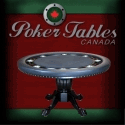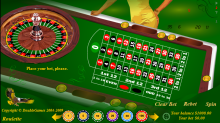The house average or house edge (also called the expected value) is the amount the player loses relative for any bet made, on average. If a player bets on a single number in the American game there is a probability of 1/38 that the player wins 35 times the bet, and a 37/38 chance that the player loses their bet. The expected value is:
−1×37/38 + 35×1/38 = −0.0526 (5.26% house edge)
For European roulette, a single number wins 1/37 and loses 36/37:
−1×36/37 + 35×1/37 = −0.0270 (2.70% house edge)
The presence of the green squares on the roulette wheel and on the table are technically the only house edge. Outside bets will always lose when a single or double zero come up. However, the house also has an edge on inside bets because the pay outs are always set at 35 to 1 when you mathematically have a 37 to 1 chance at winning a straight bet on a single number. To demonstrate the house edge on inside bets, imagine placing straight $1 wagers on all inside numbers on a roulette table (including 0 and 00) to assure a win. You would only get back 36 times your original bet having spent $38. The only exception are the five numbers bet where the house edge is considerably higher (7.89% on an American wheel), and the ‘even money’ bets in some European games where the house edge is halved because only half the stake is lost when a zero comes up.
The house edge should not be confused with the hold. The hold is the average percentage of the money originally brought to the table that the player loses before he leaves – the actual “win” amount for the casino. The Casino Control Commission in Atlantic City releases a monthly report showing the win/hold amounts for each casino. The average win/hold for double zero wheels is between 21-30%, significantly more than the 5.26% house edge. This reflects the fact that the player is ‘churning’ the same money over and over again. A 23.6% hold, for example, would imply that on average, the player bets the total he brought to the table five times, as 23.6% is approximately equal to 100% – (100% – 5.26%)^5. For example, a player with $100 making $10 bets on red (which has a near 50/50 chance of winning) is highly unlikely to lose all his money after only 10 bets, and will most likely continue to bet until he has lost all of his money or decides to leave. A player making $10 bets on a single number (with only 1/38 chance of success) with a $100 bankroll is far more likely to lose all of his money after only 10 bets. Despite being more likely to lose, the casino’s average hold from this type of player would be significantly lower than the even-money bettor, because the single number player will on average bet less money (at 5.26% expected loss per dollar bet).
In the early frontier gambling saloons, the house would set the odds on roulette tables at 27 for 1. This meant that on a $1 bet you would get $27 and the house would keep your initial dollar. Today most casino odds are set by law, and they have to be either 34 to 1 or 35 to 1. This means that the house pays you $34 or $35 and you get to keep your original $1 bet.



